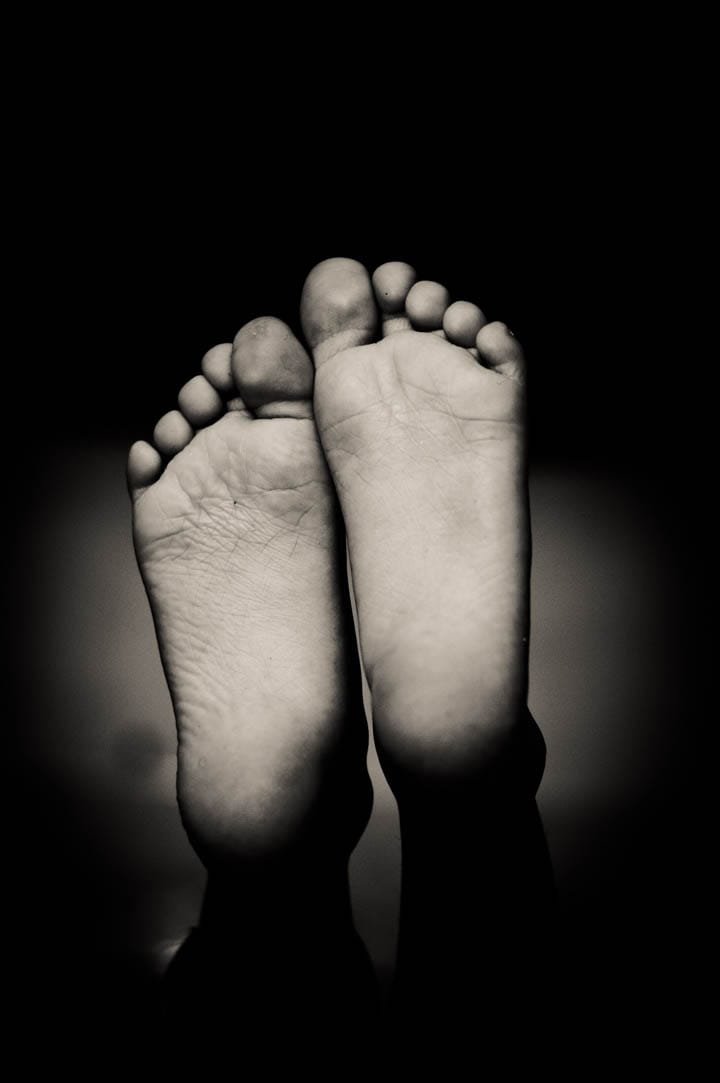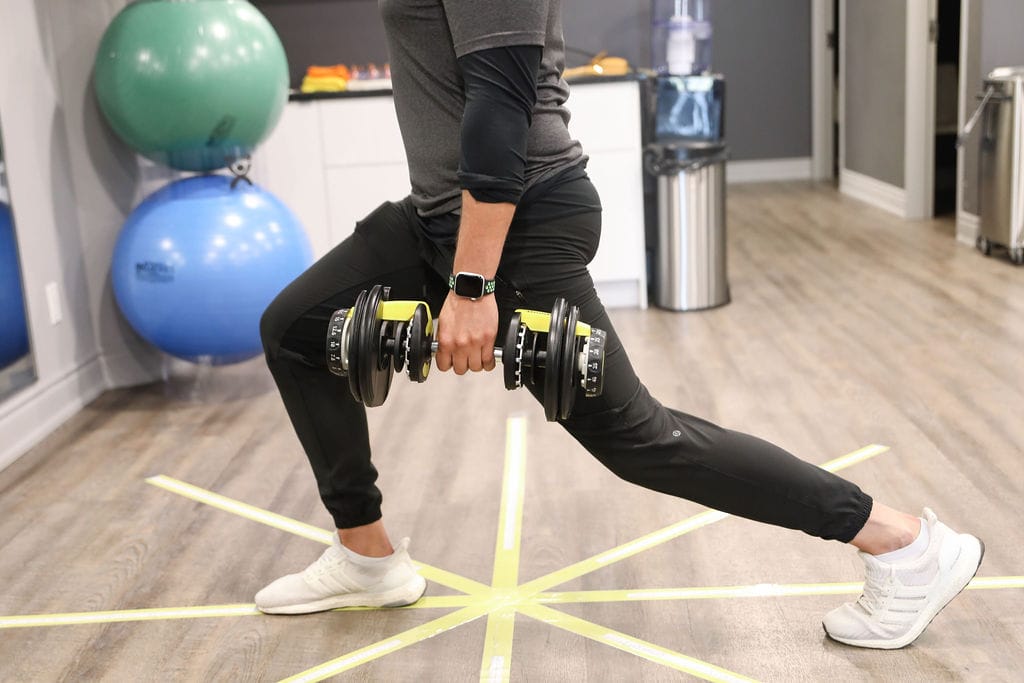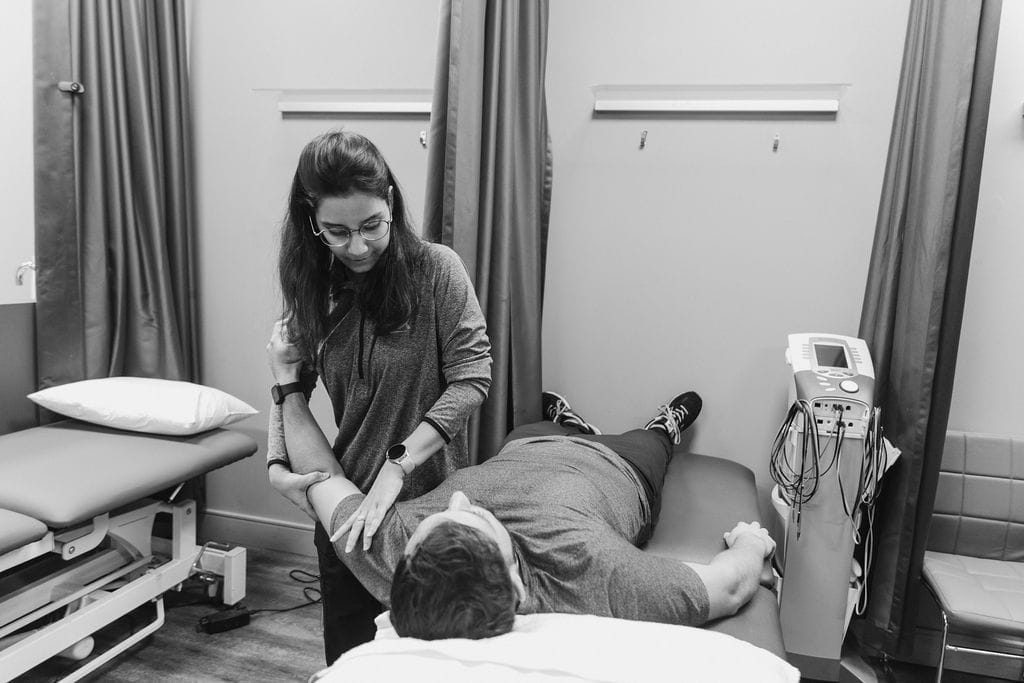Warm-up exercises are essential to prepare your body for more intense physical activity by increasing blood flow to your muscles, raising your heart rate, and improving flexibility.
Here are ten effective warm-up exercises you can perform before a workout:
- Jumping Jacks: Stand with your feet together and hands by your sides. Jump and spread your feet apart while raising your arms overhead. Jump again to return to the starting position.
- High Knees: Stand with feet hip-width apart. Lift one knee at a time towards your chest while jogging on the spot, pumping your arms as you go.
- Arm Circles: Extend your arms out to the sides and make small circles with your hands, gradually increasing the size of the circles. After a few repetitions, reverse the direction.
- Leg Swings: Hold onto a stable surface (e.g., a wall or pole) for balance. Swing one leg forward and backward, and then sideways, in a controlled manner. Repeat with the other leg.
- Hip Circles: Stand with your feet hip-width apart and place your hands on your hips. Make circles with your hips, rotating in both clockwise and counterclockwise directions.
- Bodyweight Squats: Stand with feet shoulder-width apart. Lower your body into a squat position by bending your knees and pushing your hips back. Return to the starting position and repeat.
- Arm Crosses: Extend your arms straight out to the sides at shoulder height. Cross your arms in front of your chest, then open them wide again. Continue crossing back and forth.
- Butt Kicks: Stand with feet hip-width apart. Kick your heels up towards your glutes, one leg at a time, while jogging on the spot.
- Shoulder Circles: Stand with feet shoulder-width apart. Raise your shoulders up towards your ears, then roll them backward in a circular motion. Reverse the direction after a few repetitions.
- Walking Lunges: Take a step forward with one leg and lower your body into a lunge position. Push off the front foot and bring it back to the starting position. Repeat with the other leg.
FAQs
1. How long should I spend on warm-up exercises?
Aim to spend at least 5 to 10 minutes on your warm-up routine. The duration may vary depending on the intensity of your workout and personal preferences.
2. Should I stretch during the warm-up?
Dynamic stretching, which involves moving your muscles through their range of motion, is more appropriate during the warm-up. Save static stretching (holding stretches for extended periods) for after your workout.
3. Can I skip the warm-up if I’m short on time?
It’s not advisable to skip the warm-up entirely, as it increases the risk of injury and reduces your performance during the workout. If you’re short on time, shorten the warm-up but ensure you still get your heart rate up and do some dynamic movements.
4. Can I warm up without any equipment?
Absolutely! The warm-up exercises listed above require no equipment. They use your body weight and basic movements to prepare your muscles and cardiovascular system for exercise.
5. How intense should the warm-up be?
The warm-up should be less intense than the main workout. Gradually increase the intensity of the warm-up exercises to elevate your heart rate and prepare your body for the upcoming challenges.
Remember that warm-up exercises should be tailored to your specific workout routine and individual needs. A qualified physiotherapist can assess you and determine if you have any pre-existing conditions and recommend the best pre-workout routine for you.
How do I book an appointment at a Physiotherapy Clinic near me?
Click HERE to book an appointment with a physiotherapist or chiropractor at one of our eight locations.
- Physiotherapy Etobicoke – Triangle Physiotherapy Etobicoke
- Oakville Physiotherapy Clinic – Triangle Physiotherapy Oakville
- Physiotherapy North York – Triangle Physiotherapy North York
- Mississauga Physiotherapy Clinics – Triangle Physiotherapy Mississauga
- Downtown Physiotherapy Clinics – Triangle Physiotherapy King West
- Uptown Physiotherapy Clinics – Triangle Physiotherapy Lawrence Park
- Physiotherapy Clinic Downtown Toronto – Triangle Physiotherapy Queens Quay
- Physiotherapy Clinics Mississauga – Triangle Physiotherapy Erin Mills
“Performing proper warm-up exercises before a workout is essential for preventing injuries and maximizing performance. Triangle Physiotherapy offers expert guidance and care across the GTA, including Physiotherapy in Etobicoke, Oakville, North York, Toronto, Lawrence Park, Queens Quay, Erin Mills, Mississauga, and Liberty Village. Our experienced physiotherapists can help you develop a personalized warm-up routine to ensure a safe and effective workout.”
Gardening is a favourite activity for many people as the summer season arrives. As healthcare professionals, we understand the importance of gardening in promoting physical health and well-being.

Here are some gardening tips to ensure a safe and enjoyable experience:
- Warm-Up Exercises: Treat gardening as a physical activity and warm up before starting. Perform gentle stretches for your back, shoulders, and legs to prepare your muscles for the tasks ahead.
- Maintain Good Posture: Pay attention to your posture while gardening. Bend from your knees and hips, not your back, to avoid strain. Avoid prolonged periods of bending or kneeling; take breaks and change positions frequently.
- Use Proper Lifting Techniques: When lifting heavy objects like bags of soil or pots, bend your knees, keep the object close to your body, and lift with your legs, not your back. Avoid sudden twisting movements.
- Choose Ergonomic Tools: Invest in high-quality, ergonomic gardening tools that reduce strain on your joints and muscles. Look for tools with padded handles and adjustable lengths.
- Start Slowly: If you’re new to gardening or haven’t done it in a while, start with lighter tasks and gradually increase your gardening time and intensity to build endurance and strength.
- Alternate Activities: Vary your gardening tasks to avoid overusing specific muscles. Switch between planting, weeding, and watering to distribute the workload.
- Garden at Waist Height: If possible, create raised garden beds or use elevated planters to reduce the need for bending and kneeling.
- Use Knee Pads or Cushions: Protect your knees by using knee pads or cushions when kneeling on the ground.
- Stay Hydrated: Gardening can be physically demanding, so remember to drink water regularly to stay hydrated, especially on hot days.
- Take Breaks: Listen to your body and take breaks as needed. Use your break time to stretch and relax.
- Ask for Help: If a task seems too challenging or requires heavy lifting, don’t hesitate to ask for assistance from family members or friends.
- Cool Down and Stretch: After gardening, take a few minutes to cool down and stretch your muscles to prevent stiffness and promote flexibility.
What are some common gardening postures that can lead to discomfort or injury?
Several gardening postures can lead to discomfort or injury if not done with proper form and technique. Some common ones include:
- Bending from the Waist
- Kneeling on Hard Surfaces
- Repetitive Twisting
- Overreaching
- Incorrect Lifting
How can I avoid discomfort while gardening?
To avoid discomfort while gardening, consider the following tips:
- Use Proper Posture
- Take Breaks
- Use Knee Pads or a Kneeler
- Alternate Tasks
- Garden at Waist Height
- Use Ergonomic Tools
- Lift Properly
- Stretch Before and After
Can gardening worsen pre-existing musculoskeletal conditions?
Yes, gardening can exacerbate pre-existing musculoskeletal conditions if proper precautions are not taken. People with conditions like osteoarthritis, back pain, or joint issues may be more susceptible to discomfort or injury while gardening. However, with proper body mechanics, adaptive tools, and awareness of limitations, gardening can still be enjoyed safely. It’s essential for individuals with pre-existing conditions to consult their physiotherapist or chiropractor before engaging in gardening to get personalized recommendations and precautions.
I often experience neck and shoulder pain after a day of gardening. How can I prevent this discomfort?
Neck and shoulder pain after gardening can result from poor posture and overuse of certain muscles. Here’s how to prevent discomfort:
- Maintain Proper Posture: Keep your head aligned with your spine and avoid prolonged forward head posture while working in the garden.
- Avoid Overreaching: Use gardening tools with extended handles to reduce strain on your shoulders. Avoid overreaching when pruning or planting.
- Take Frequent Breaks: Schedule regular breaks during gardening to rest your neck and shoulder muscles.
- Incorporate Shoulder Exercises: Perform shoulder-strengthening exercises recommended by a physiotherapist to improve muscle endurance and stability.
- Warm-Up Before Gardening: Engage in light shoulder and neck stretches to prepare your muscles for gardening tasks.
- Use Proper Lifting Techniques: Lift objects close to your body and use your leg muscles to minimize strain on your neck and shoulders.
- Ice and Heat Therapy: Apply ice to sore areas after gardening to reduce inflammation, and use heat packs to relax tense muscles.
Can gardening worsen my existing back condition? Can physiotherapy help?
Gardening can potentially worsen existing back conditions if proper precautions are not taken. Physiotherapy can certainly help to alleviate back pain and prevent it from affecting your gardening game. Individuals with back issues should consider the following:
- Consult a Physiotherapist: Seek advice from a physiotherapist to assess your back condition and receive personalized recommendations for gardening.
- Avoid Heavy Lifting: Refrain from lifting heavy objects that could strain your back. Use lightweight containers and gardening tools.
- Choose Low-Impact Tasks: Opt for low-impact gardening activities such as container gardening or raised beds to minimize strain on your back.
- Use Assistive Devices: Consider using gardening tools with ergonomic designs or assistive devices to reduce stress on your back.
- Pace Yourself: Take frequent breaks and limit the duration of gardening sessions to avoid overexertion.
- Engage in Back Exercises: Perform back-strengthening exercises prescribed by your physiotherapist to improve the stability and flexibility of your spine.
How do I book an appointment at a Physiotherapy Clinic near me?
Click HERE to book an appointment with a physiotherapist or chiropractor at one of our eight locations.
- Physiotherapy Etobicoke – Triangle Physiotherapy Etobicoke
- Oakville Physiotherapy Clinic – Triangle Physiotherapy Oakville
- Physiotherapy North York – Triangle Physiotherapy North York
- Mississauga Physiotherapy Clinics – Triangle Physiotherapy Mississauga
- Downtown Physiotherapy Clinics – Triangle Physiotherapy King West
- Uptown Physiotherapy Clinics – Triangle Physiotherapy Lawrence Park
- Physiotherapy Clinic Downtown Toronto – Triangle Physiotherapy Queens Quay
- Physiotherapy Clinics Mississauga – Triangle Physiotherapy Erin Mills
“Gardening is a rewarding activity, but it’s important to stay injury-free during the summer. Triangle Physiotherapy offers expert services across the GTA, including Physiotherapy in Etobicoke, Oakville, North York, Toronto, Lawrence Park, Queens Quay, Erin Mills, Mississauga, and Liberty Village. Our experienced physiotherapists can help you prevent and manage injuries, ensuring that you can enjoy your gardening activities all season long.”
A physiotherapist and chiropractor specialize in diagnosing, treating, and preventing various physical conditions and injuries. Both of these health professionals have extensive training in helping patients with various injuries and chronic health conditions.
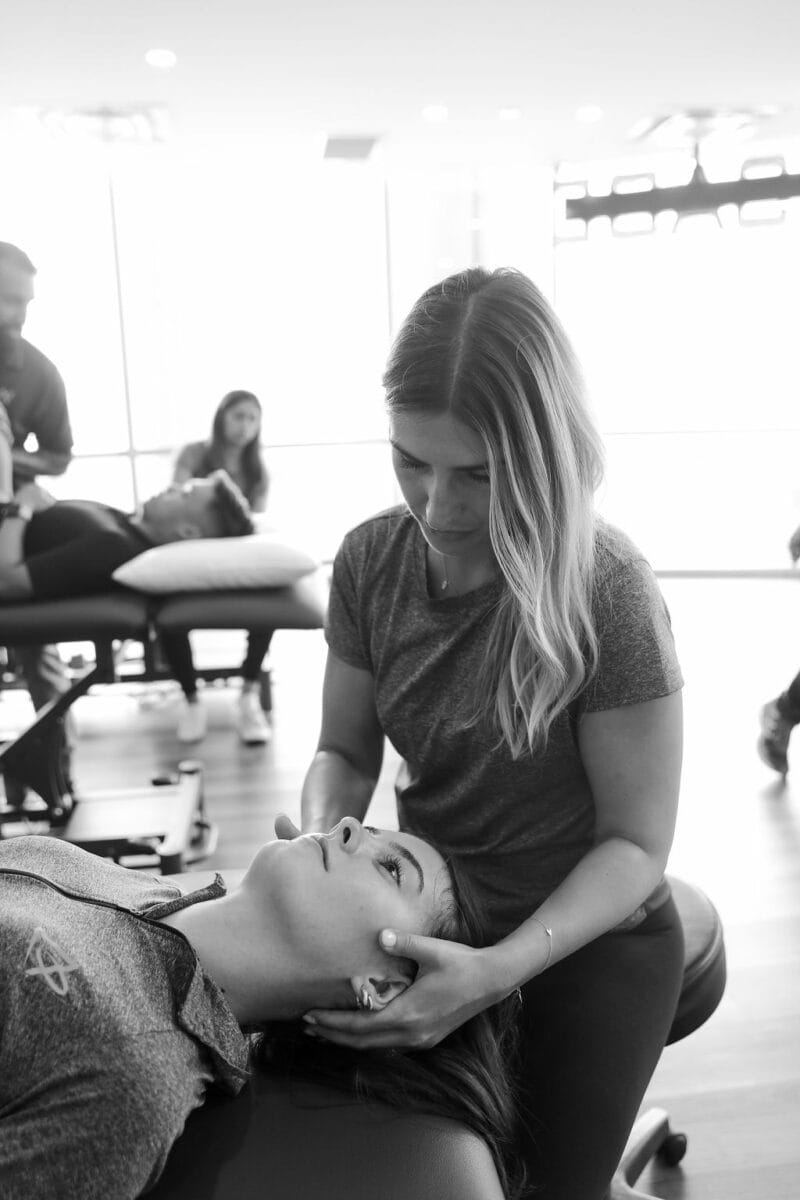
How are physiotherapy and chiropractic treatments similar?
1. Focus on Musculoskeletal System: Both physiotherapy and chiropractic treatment focus on the musculoskeletal system, which includes the bones, muscles, joints, and nerves. They seek to address issues related to these structures to alleviate pain and improve mobility.
2. Non-Invasive Approaches: Both physiotherapy and chiropractic treatment generally use non-invasive techniques to manage musculoskeletal conditions. They emphasize hands-on therapies and exercises rather than relying on medication or surgery.
3. Patient-Centered Care: Both approaches prioritize patient-centered care, tailoring treatment plans to individual needs and conditions. They consider the patient’s specific symptoms, medical history, lifestyle, and goals to design effective and personalized treatment strategies.
4. Pain Relief: Both physiotherapists and chiropractors work to alleviate pain caused by musculoskeletal issues. They use manual therapies and exercises to reduce discomfort and promote healing.
5. Holistic Approach: Both physiotherapy and chiropractic treatment take a holistic approach to healthcare. They consider not only the physical symptoms but also the patient’s overall well-being and lifestyle factors that may contribute to their condition.
6. Rehabilitation and Injury Prevention: Both physiotherapists and chiropractors play a role in injury rehabilitation. They assist patients in recovering from injuries, surgeries, or accidents, and they provide guidance on preventing future injuries through proper techniques and exercises.
7. Emphasis on Patient Education: Physiotherapists and chiropractors both emphasize patient education. They educate patients about their conditions, treatment options, and ways to maintain or improve their health through exercise, posture, and lifestyle adjustments.
8. Complementary Approaches: In some cases, physiotherapists and chiropractors work together or in conjunction with other healthcare professionals to provide comprehensive care for patients. Their complementary approaches can enhance treatment outcomes for certain conditions.
9. Evidence-Based Practice: Both physiotherapy and chiropractic treatment rely on evidence-based practices. They incorporate the latest research and clinical evidence to inform their treatment decisions, ensuring that patients receive the most effective and safe care.
10. Wellness Promotion: Beyond treating specific conditions, both physiotherapists and chiropractors promote overall wellness and health. They focus on enhancing physical function and quality of life, helping patients lead active and fulfilling lives.
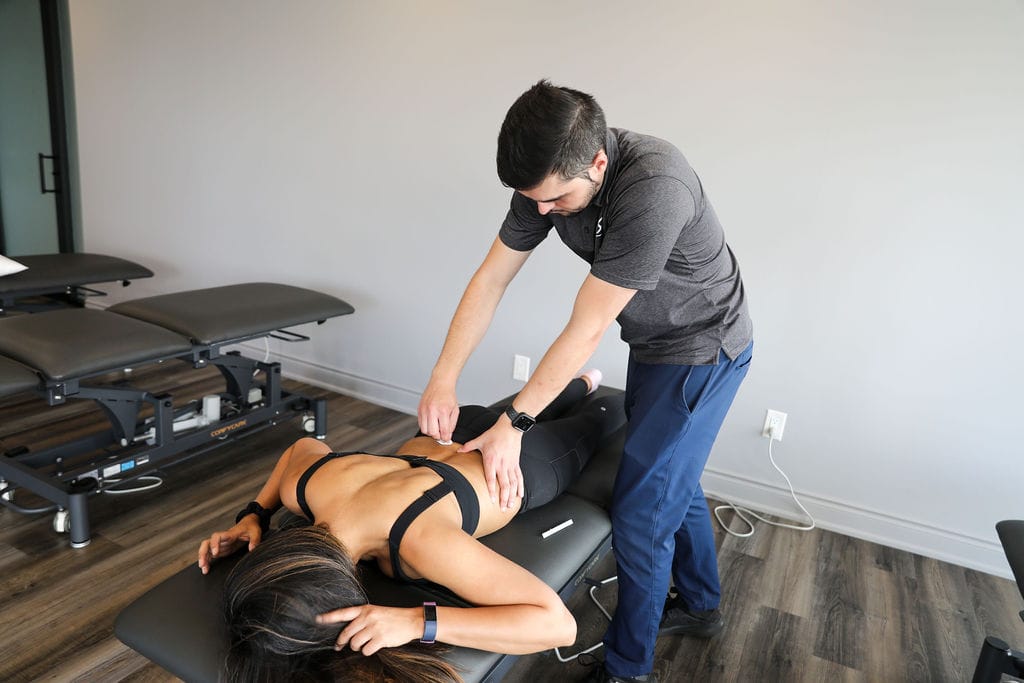
What is chiropractic?
Chiropractic is a licensed healthcare profession that emphasizes the body’s ability to heal itself. Treatment typically involves manual therapy, often including spinal manipulation which helps restore joint function.
What are the benefits of seeing a chiropractor?
Chiropractors do more than just help with back or spine issues. There are a variety of benefits of going to a chiropractor. Chiropractic care also helps improve your mental health, flexibility, muscle strength, and range of motion.
What can I expect from my chiropractic appointment?
When attending Triangle Physiotherapy for the first time, you will be asked to fill in a new patient information form prior to your initial visit. We highly recommend filling out your forms at home through our user-friendly patient portal, the link for which will be sent to you as soon as you book your session.
We will endeavor to make your first visit to our clinic a comfortable and rewarding experience.
At your initial consultation, your chiropractors will:
- Conduct a thorough examination including history taking and a physical assessment
- Give you a working diagnosis of your condition
- Education
- Treatment Plan
I am in search of a physiotherapy clinic near me that offers chiropractic services and would like to start treatment at your physiotherapy center right away. Would I be needing a doctor’s referral to see a chiropractor at clinics?
You can certainly start treatment at any of our physiotherapy clinics right away and we would not be needing a doctor’s referral unless your insurance requires one. If you do need a doctor’s referral and don’t have immediate access to a doctor, we would be happy to refer you to an online doctor service that helps many of our patients.
I would like to see a chiropractor near me to help me with my neck pain. I have heard that you offer the best chiropractic service near me. How do I book an appointment at a Triangle Physiotherapy Clinic near me?
Click HERE to book an appointment with a chiropractor at one of our eight locations.
- Physiotherapy Etobicoke – Triangle Physiotherapy Etobicoke
- Oakville Physiotherapy Clinic – Triangle Physiotherapy Oakville
- Physiotherapy North York – Triangle Physiotherapy North York
- Mississauga Physiotherapy Clinics – Triangle Physiotherapy Mississauga
- Downtown Physiotherapy Clinics – Triangle Physiotherapy King West
- Uptown Physiotherapy Clinics – Triangle Physiotherapy Lawrence Park
- Physiotherapy Clinic Downtown Toronto – Triangle Physiotherapy Queens Quay
- Physiotherapy Clinics Mississauga – Triangle Physiotherapy Erin Mills
“Understanding the difference between a physiotherapist and a chiropractor is key to choosing the right care for your needs. Triangle Physiotherapy offers expert services across the GTA, including Physiotherapy in Etobicoke, Oakville, North York, Toronto, Lawrence Park, Queens Quay, Erin Mills, Mississauga, and Liberty Village. Our experienced team is here to help you find the best approach to managing your health and achieving your wellness goals.”
Yes, a physiotherapist can definitely help with plantar fasciitis. They can provide specialized exercises, stretching techniques, and other treatments to alleviate pain, improve mobility, and promote healing of the plantar fascia.
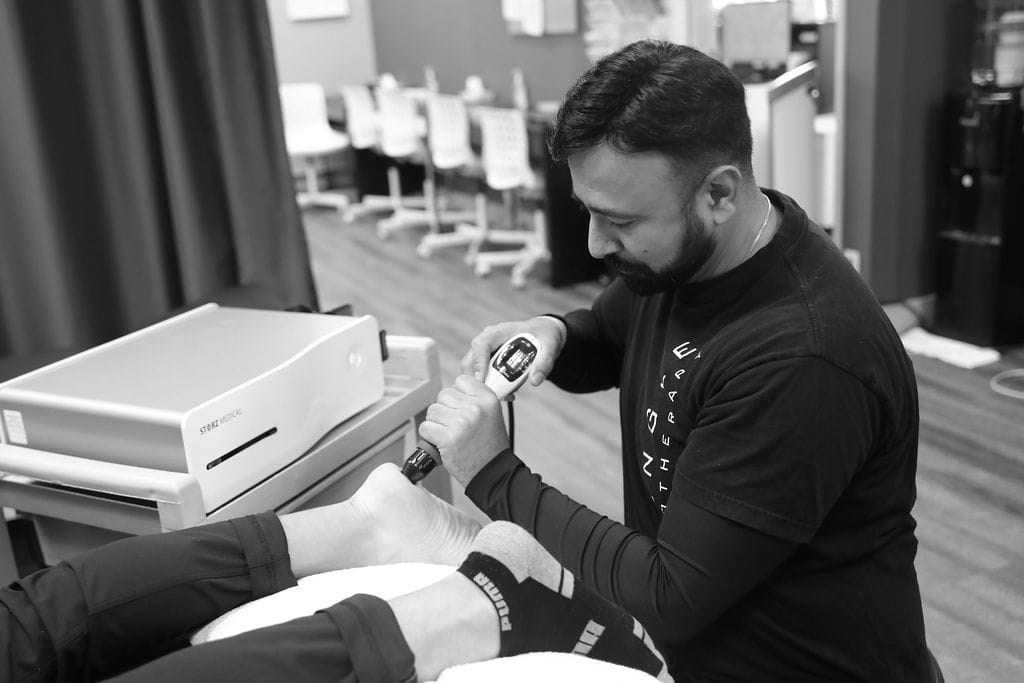
What is plantar fasciitis and what causes it?
Plantar Fasciitis is a painful condition resulting from inflammation of a band of connective tissue located on the bottom side of the foot known as the Plantar Fascia. This band of connective tissue runs from the heel of the foot, all the way to the base of each toe, and it functions to support the arch of the foot, especially during weight-bearing.
What are the symptoms of plantar fasciitis?
The pain associated with Plantar Fasciitis is located on the bottom of the foot, with it often manifesting around the heel and along the inside of the foot. It is common for this pain to be at its worst first thing in the morning, and it is usually accompanied by other symptoms, such as stiffness, weakness, swelling, and decreased proprioception.
How is it diagnosed by a physiotherapist?
A Physiotherapist will run a thorough examination of the problem to ensure a proper diagnosis is obtained. This will include getting a detailed history, observing the area and how you function, and running through a series of specific tests. From there, an individualized treatment plan will be made for you to help you achieve your goals and assist you on your road to recovery.
Who is the most at risk to develop this condition?
Plantar Fasciitis is more common in people who can relate to the following:
- Have flat feet or high arches
- Have tight calf muscles
- Wear improper footwear
- Engage in repetitive physical activity (overtraining)
- Suddenly changed activity levels (increased frequency, duration, or intensity)
- Suddenly changed activity or training environment
- Work in an environment that requires prolonged standing
What is the best treatment for plantar fasciitis?
Physiotherapy is considered to be very effective in treating plantar fasciitis. The treatment starts with managing the initial pain and symptoms after which the soft tissue is gradually loaded to promote strengthening so that the condition does not reoccur.
What does plantar fasciitis treatment look like?
Plantar Fasciitis treatment can include one or more of the following:
- Rest: Avoid activities that worsen the pain and give your feet time to heal.
- Ice: Applying ice to the affected area can help reduce inflammation and pain.
- Stretching: Regularly perform calf and foot stretches to help improve flexibility and reduce tension on the plantar fascia.
- Footwear: Choose supportive and cushioned shoes that provide proper arch support.
- Orthotics: Custom or over-the-counter shoe inserts can help distribute pressure evenly on the foot.
- Night splints: These devices keep the foot in a stretched position overnight to alleviate morning pain.
- Physiotherapy: A physiotherapist can guide you through exercises and treatments to aid recovery.
- Extracorporeal Shock Wave Therapy (ESWT): In some cases, this treatment may be used to stimulate healing.
Click HERE to book an appointment with a physiotherapist at one of our eight locations.
- Physiotherapy Etobicoke – Triangle Physiotherapy Etobicoke
- Oakville Physiotherapy Clinic – Triangle Physiotherapy Oakville
- Physiotherapy North York – Triangle Physiotherapy North York
- Mississauga Physiotherapy Clinics – Triangle Physiotherapy Mississauga
- Downtown Physiotherapy Clinics – Triangle Physiotherapy King West
- Uptown Physiotherapy Clinics – Triangle Physiotherapy Lawrence Park
- Physiotherapy Clinic Downtown Toronto – Triangle Physiotherapy Queens Quay
- Physiotherapy Clinics Mississauga – Triangle Physiotherapy Erin Mills
“Plantar fasciitis can be effectively managed with the help of a skilled physiotherapist. Triangle Physiotherapy offers expert care across the GTA, including Physiotherapy in Etobicoke, Oakville, North York, Toronto, Lawrence Park, Queens Quay, Erin Mills, Mississauga, and Liberty Village. Our experienced team can develop a personalized treatment plan to alleviate your symptoms and help you get back on your feet.”
Vestibular rehabilitation therapy (VRT) is a specialized form of therapy designed to treat problems related to the vestibular system, which is responsible for our sense of balance and spatial orientation. It is commonly used to address issues such as dizziness, vertigo, imbalance, and other symptoms associated with vestibular disorders.
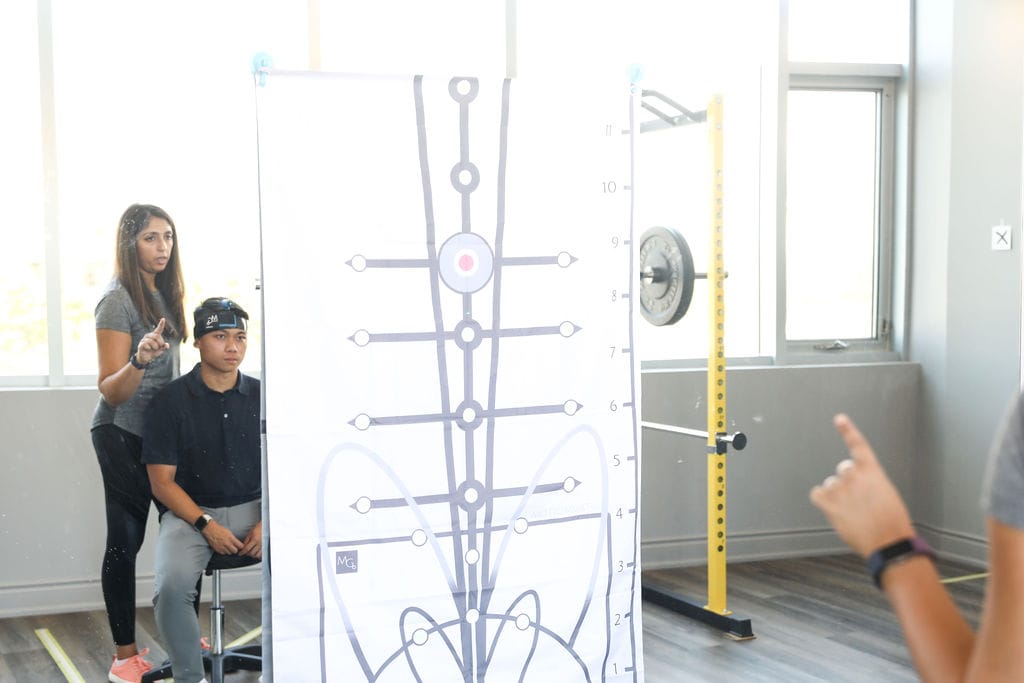
What are the symptoms of Vestibular Dysfunction?
The symptoms of vestibular disorder are:
- Dizziness: This is a sensation of lightheadedness, unsteadiness, or feeling like you or your surroundings are spinning (vertigo). Vertigo can be intense and can lead to nausea and vomiting in some cases.
- Imbalance and unsteadiness: Problems with balance and coordination are common in vestibular dysfunction. Individuals may feel off-balance, have difficulty walking in a straight line, or experience a tendency to veer or fall to one side.
- Nausea and vomiting: The sensation of vertigo can trigger feelings of nausea, which may lead to vomiting in some cases.
- Visual disturbances: Vestibular dysfunction can affect vision, causing blurring, difficulty focusing, or sensitivity to light and movement. Visual disturbances can worsen dizziness and disorientation.
- Tinnitus: Some individuals with vestibular dysfunction may experience ringing, buzzing, or other abnormal sounds in their ears (tinnitus).
- Sensitivity to motion: Motion sensitivity or an increased sensitivity to movement, known as motion intolerance, is common in vestibular dysfunction. Everyday activities like riding in a car, using escalators, or even watching fast-paced visual stimuli may trigger symptoms.
- Cognitive difficulties: Vestibular dysfunction can sometimes lead to problems with concentration, memory, and cognitive processing. Some individuals may experience difficulty thinking clearly or have a foggy or spaced-out feeling.
- Fatigue and anxiety: The physical and emotional stress caused by vestibular dysfunction can lead to feelings of fatigue and exhaustion. Anxiety and depression can also accompany vestibular disorders due to their impact on daily functioning and quality of life.
What is the Vestibular System?
The vestibular system is a complex sensory system located within the inner ear. It plays a crucial role in maintaining balance, spatial orientation, and coordination of head and eye movements. It is made up of:
- The vestibular organs
- The vestibular nerve
- The brainstem and the cerebellum
The vestibular system works in close conjunction with the visual system and proprioceptive system (sensory input from muscles and joints) to provide a comprehensive sense of spatial orientation and balance. It helps us maintain stable posture, make coordinated movements, and adjust our gaze to keep objects in focus during head and body movements.
When the vestibular system malfunctions or becomes disrupted, it can result in various vestibular disorders, leading to symptoms such as dizziness, vertigo, and imbalance. Vestibular rehabilitation therapy, as mentioned earlier, aims to address these issues by helping the brain adapt to vestibular dysfunction and restore normal function.
What types of conditions can benefit from Vestibular Rehabilitation Therapy?
Vestibular rehabilitation therapy (VRT) can be beneficial for various conditions that involve vestibular dysfunction or impairments in balance and spatial orientation. Some of the conditions that can benefit from VRT include:
- Benign Paroxysmal Positional Vertigo (BPPV): BPPV is a common vestibular disorder characterized by brief episodes of vertigo triggered by specific head movements. VRT can include canalith repositioning procedures, such as the Epley maneuver or the Semont maneuver, which aim to reposition displaced calcium crystals in the inner ear and alleviate symptoms.
- Vestibular Neuritis: Vestibular neuritis is an inflammation of the vestibular nerve typically caused by a viral infection. It results in severe vertigo, dizziness, and imbalance. VRT can help improve balance, reduce dizziness, and promote compensation for the damaged vestibular system.
- Labyrinthitis: Labyrinthitis is an inflammation of the inner ear labyrinth, often caused by a viral or bacterial infection. It leads to vertigo, dizziness, hearing loss, and sometimes ringing in the ears (tinnitus). VRT can aid in managing the dizziness and balance issues associated with labyrinthitis.
- Ménière’s Disease: Ménière’s disease is a chronic condition characterized by recurring episodes of vertigo, fluctuating hearing loss, tinnitus, and a feeling of fullness in the ear. VRT can be beneficial in managing dizziness and improving balance control during and between attacks.
- Post-Concussion Syndrome: After a concussion or traumatic brain injury, vestibular dysfunction can occur, leading to symptoms such as dizziness, imbalance, and difficulty concentrating. VRT can help address these symptoms, promote recovery, and improve overall function.
- Age-related Balance Disorders: As people age, they may experience age-related changes in the vestibular system, leading to balance problems. VRT can help older individuals improve their balance, reduce the risk of falls, and enhance their overall quality of life.
- Mal de Débarquement Syndrome (MdDS): MdDS is a disorder characterized by a persistent sensation of rocking or swaying, typically following a prolonged exposure to motion, such as a boat or plane ride. VRT can be used to help the brain readapt and reduce the sensation of motion.
- Unilateral or Bilateral Vestibular Hypofunction: When there is a significant reduction in vestibular function on one or both sides, it can result in balance deficits and dizziness. VRT can assist in compensating for the reduced vestibular input and improve balance control.
It’s important to note that the specific treatment approach may vary depending on the individual’s condition, symptoms, and the expertise of the healthcare professional providing the therapy. A qualified vestibular specialist or physiotherapist trained in vestibular rehabilitation can assess the individual’s needs and develop a tailored treatment plan for optimal outcomes.
Can Vestibular Rehabilitation Therapy help me?
You can certainly benefit from vestibular physiotherapy even if your condition is chronic. Through a variety of exercises and techniques, vestibular physiotherapy aims to enhance balance, reduce dizziness, and improve overall function of the vestibular system. With the help of various exercises and techniques vestibular physiotherapy can help reduce your dizziness, improve your balance and enhance the quality of your life.
Vestibular Physiotherapy Near Me
Click HERE to book an appointment with a vestibular rehabilitation physiotherapist at one of our eight locations.
- Physiotherapy Etobicoke – Triangle Physiotherapy Etobicoke
- Oakville Physiotherapy Clinic – Triangle Physiotherapy Oakville
- Physiotherapy North York – Triangle Physiotherapy North York
- Mississauga Physiotherapy Clinics – Triangle Physiotherapy Mississauga
- Downtown Physiotherapy Clinics – Triangle Physiotherapy King West
- Uptown Physiotherapy Clinics – Triangle Physiotherapy Lawrence Park
- Physiotherapy Clinic Downtown Toronto – Triangle Physiotherapy Queens Quay
- Physiotherapy Clinics Mississauga – Triangle Physiotherapy Erin Mills
“Vestibular Rehabilitation Therapy (VRT) is a specialized form of physiotherapy designed to alleviate symptoms of vertigo and dizziness. Triangle Physiotherapy offers expert VRT services across the GTA, including Physiotherapy in Etobicoke, Oakville, North York, Toronto, Lawrence Park, Queens Quay, Erin Mills, Mississauga, and Liberty Village. Our experienced physiotherapists can help you regain balance and improve your quality of life through tailored vestibular rehabilitation programs.”
Yes, physiotherapy can help with knee pain.
Knee pain is a very common complaint, and is something that can originate from many different structures in and around the knee. The knee joint is made up of the interaction between the femur (thigh), the tibia (shin), and the patella (kneecap). All the tissues around these areas can be contributing to your knee pain.
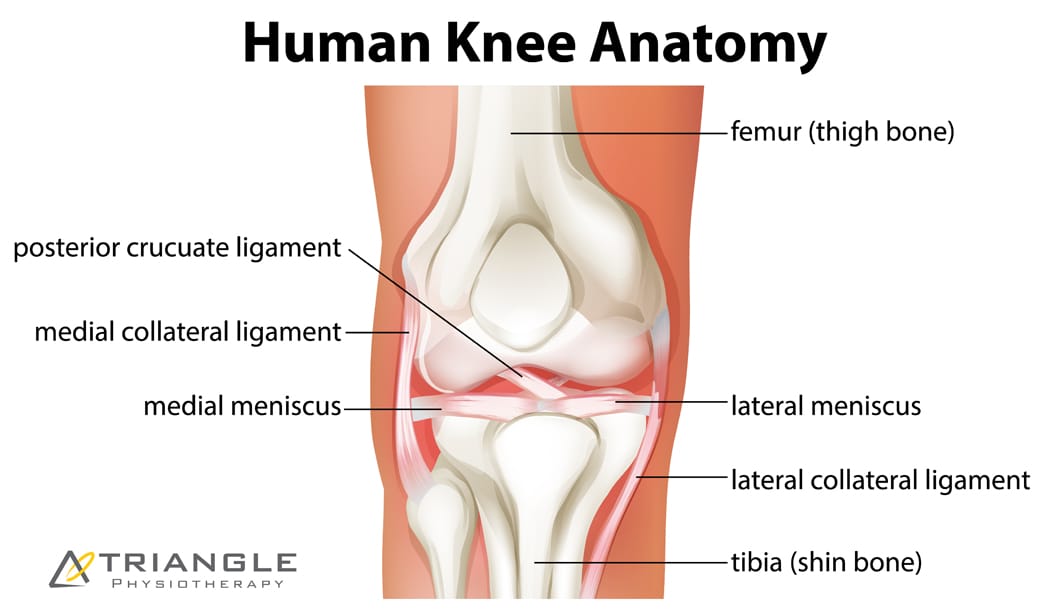
How does physiotherapy help with knee pain?
Here are some ways in which physiotherapy can help with knee pain:
- Pain management: Physiotherapists can utilize various modalities such as manual therapy, heat or cold therapy, and electrical stimulation to help alleviate pain and reduce inflammation in the knee joint.
- Exercise prescription: Specific exercises can be prescribed to strengthen the muscles around the knee joint, improve flexibility, and enhance joint stability. These exercises help restore normal movement patterns, reduce stress on the knee joint, and promote healing.
- Manual therapy: Physiotherapists may use hands-on techniques like joint mobilization or soft tissue massage to improve joint mobility, reduce muscle tension, and enhance circulation in the knee area.
- Education and self-management: Physiotherapists provide education about proper body mechanics, posture, and ergonomics to prevent further knee pain or injury. They may also offer guidance on activity modification and self-management strategies to promote long-term knee health.
- Assistive devices and bracing: If necessary, physiotherapists can recommend and provide appropriate assistive devices such as knee braces or orthotics to support the knee joint and reduce pain during movement.
What are the causes of knee pain?
Knee pain can have various causes, ranging from acute injuries to chronic conditions. Here are some common causes of knee pain:
- Acute injuries: Knee pain can result from sudden injuries, such as sprains, strains, ligament tears (such as anterior cruciate ligament or ACL tears), meniscus tears, or fractures. These injuries often occur during sports activities, accidents, or falls.
- Overuse or repetitive strain: Repetitive activities or excessive stress on the knee joint can lead to overuse injuries. Examples include patellofemoral pain syndrome (pain around the front of the knee), iliotibial band syndrome (inflammation of the band of tissue on the outside of the knee), or tendinitis (inflammation of a tendon, such as patellar tendinitis or jumper’s knee).
- Osteoarthritis: This is a degenerative joint disease characterized by the breakdown of cartilage in the knee joint. It is more common in older individuals and can cause knee pain, stiffness, and swelling.
- Rheumatoid arthritis: Unlike osteoarthritis, rheumatoid arthritis is an autoimmune condition that causes inflammation and damage to the joints, including the knee. It can lead to chronic pain, joint deformity, and functional limitations.
- Bursitis: Bursae are small fluid-filled sacs that cushion and reduce friction between tendons, ligaments, and bones. When the bursae become inflamed (bursitis), it can cause knee pain, swelling, and limited mobility.
- Patellar dislocation or instability: This occurs when the kneecap (patella) slips out of its normal position, often due to a sudden change in direction or a direct blow to the knee. It can cause severe pain, swelling, and instability.
- Gout: Gout is a type of arthritis caused by the buildup of uric acid crystals in the joints. It can affect the knee joint, leading to sudden and intense pain, redness, and swelling.
- Tumors: Although rare, tumors can develop in the bones or soft tissues around the knee joint, leading to knee pain and swelling.
What are some of the conditions associated with knee pain?
Some of the conditions associated with knee pain are:
- Patellar Tendonitis
- Patellofemoral Syndrome
- Osgood Schlatter Syndrome
- Knee Bursitis
- Knee osteoarthritis
- Baker’s Cyst
- Knee Ligament Injuries
How to treat knee pain at home
You can treat knee pain at home by doing some of the following:
- Rest: Avoid activities that aggravate the pain and give your knee sufficient rest. This can help reduce inflammation and promote healing.
- Ice therapy: Apply ice packs wrapped in a thin cloth to the affected knee for about 15-20 minutes at a time, several times a day. This can help reduce pain and swelling. Be sure to allow your knee to warm up between icing sessions.
- Compression: Use a compression bandage or knee brace to provide support and reduce swelling. However, make sure it’s not too tight to restrict circulation.
- Elevation: Elevate your leg and place a pillow under your knee to help reduce swelling.
- Over-the-counter pain relievers: Nonsteroidal anti-inflammatory drugs (NSAIDs), such as ibuprofen or naproxen, can help relieve pain and reduce inflammation. Follow the instructions on the package and consult with a pharmacist if you have any concerns.
- Gentle exercises: Once the acute pain and swelling have subsided, gentle range-of-motion exercises and stretching can help improve mobility and reduce stiffness. However, avoid any exercises that cause pain or discomfort. Consult with a physiotherapist for appropriate exercises.
If you’re experiencing knee pain, it’s recommended to consult with a healthcare professional, such as a physician or physiotherapist, for an accurate diagnosis and appropriate treatment.
Click HERE to book an appointment with a physiotherapist at one of our eight locations.
- Physiotherapy Etobicoke – Triangle Physiotherapy Etobicoke
- Oakville Physiotherapy Clinic – Triangle Physiotherapy Oakville
- Physiotherapy North York – Triangle Physiotherapy North York
- Mississauga Physiotherapy Clinics – Triangle Physiotherapy Mississauga
- Downtown Physiotherapy Clinics – Triangle Physiotherapy King West
- Uptown Physiotherapy Clinics – Triangle Physiotherapy Lawrence Park
- Physiotherapy Clinic Downtown Toronto – Triangle Physiotherapy Queens Quay
- Physiotherapy Clinics Mississauga – Triangle Physiotherapy Erin Mills
“Physiotherapy is a highly effective approach for managing and alleviating knee pain, whether due to injury or chronic conditions. Triangle Physiotherapy provides expert care across the GTA, including Physiotherapy in Etobicoke, Oakville, North York, Toronto, Lawrence Park, Queens Quay, Erin Mills, Mississauga, and Liberty Village. Our experienced physiotherapists can develop a personalized treatment plan to help you reduce pain, improve mobility, and enhance your quality of life.”
Physiotherapy is an evidence-based regulated healthcare profession that aims to maintain, restore and improve your function after disease or injury, so you can get back to doing what you love and enjoy an injury-free lifestyle that doesn’t hold you back.
Physiotherapists are primary healthcare professionals with a significant role in health promotion and treatment of injury and disease.
They combine their in-depth knowledge of the body and how it works with specialized hands-on clinical skills to assess, diagnose and treat symptoms of illness, injury, or disability.
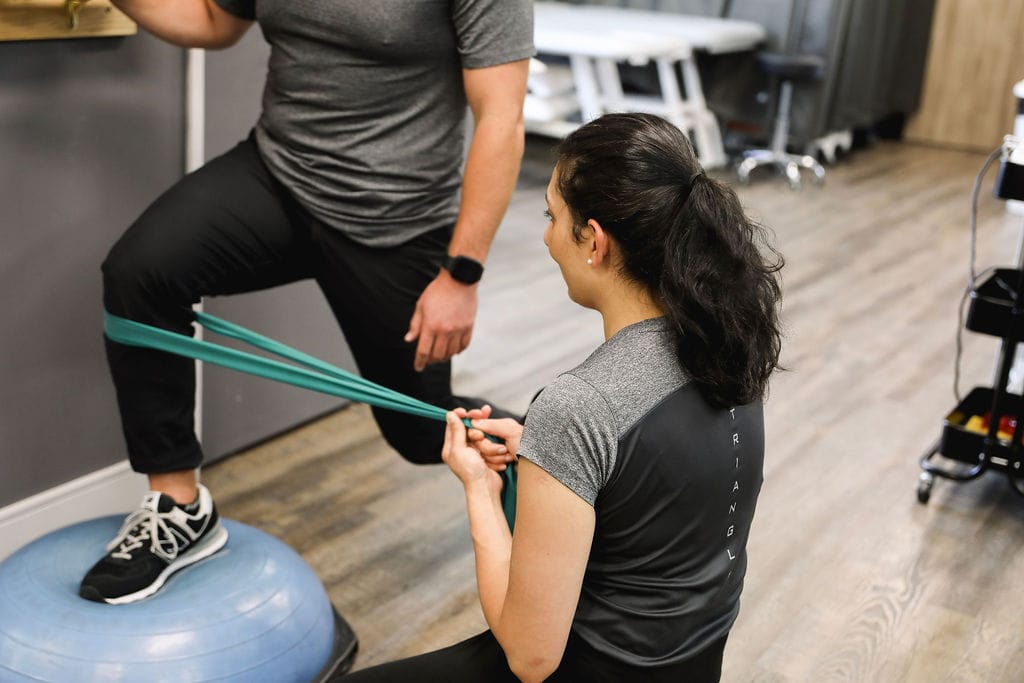
What is the average cost of physiotherapy near me?
The cost of physiotherapy depends on the appointment type and setting.
An initial assessment at a private practice typically costs between $120 to $150 in the Greater Toronto Area. Follow-ups at a private practice may cost between $80 and $110 per session. The numbers will vary based on the location of the clinics and various other factors.
What are the contributing factors to the cost of physiotherapy near me?
The cost of physiotherapy services is driven by factors such as:
- Type of service provided
- Length of session
- Physiotherapist’s specialty (Pelvic Health, Vestibular, and Concussion Rehab)
- The geographical location of the clinic
- Insurance reimbursement rates
Does insurance cover Physiotherapy?
Insurance plans may cover physiotherapy but every insurance plan is different, so, it may be prudent to check the details of your plan. Some questions to ask your insurance provider are:
- What is the annual coverage limit for physiotherapy?
- Is there a per-visit maximum, if any?
- Are there any required co-payments?
- Is the fee covered 100%?
- Is there a deductible?
How much will my physiotherapy treatments cost in total?
The cost of physiotherapy depends on the type and complexity of your injury or condition that is being treated as well as the treatment plan that your physiotherapist designs for you while keeping in mind your goals for recovery.
Why do I need to be treated by a registered physiotherapist?
It is of utmost importance to ensure that you are being seen by a registered Physiotherapist because behind every registered Physiotherapist are years of academic and clinical training as well as extensive knowledge of all the systems of the human body. At our physiotherapy center, we guarantee that every single physiotherapist we have is registered with the College of Physiotherapists of Ontario and will take excellent care of you.
Who do I speak to about the cost of physiotherapy near me?
Contact our patient care coordinator team at any of our eight locations. They will help you with any insurance-related questions you may have as well as match you with a physiotherapist best suited for your injury or condition.
Is it worth it to see a physiotherapist?
Seeing a physiotherapist can be very beneficial in many situations. Physiotherapy is a healthcare profession that focuses on improving and restoring physical function and mobility. Whether it’s addressing a specific injury, managing chronic pain, or enhancing overall physical well-being, a physiotherapist can provide valuable guidance and treatment.
Joining Physiotherapy Oakville offers you access to a team of skilled professionals who utilize evidence-based practices to tailor treatments to your specific needs. Scientific studies have shown that physiotherapy can significantly improve recovery times and physical outcomes. By becoming a part of Physiotherapy Oakville, you benefit from personalized care plans that enhance your physical health, help manage pain effectively, and support your overall well-being, ensuring you achieve the best possible outcomes.
Seein a physiotherapist costs less than what you would pay in terms of compromising your quality of life and being in pain.
Seeing a physiotherapist can help you:
- Get back to your favourite activity or sport
- Recover from an injury or surgery
- Get educated on how to exercise safely, manage painful episodes, improve your posture and more.
- Return to work after an injury
- Rehabilitate after an automobile accident
- Recover after childbirth
- and more.
Our More Locations
Physiotherapy Etobicoke | Physiotherapy Oakville | Physiotherapy North York | Physiotherapy Toronto | Physiotherapy Lawrence Park | Physiotherapy Mississauga | Physiotherapy Queens Quay | Physiotherapy Mississauga Erin Mills | Physiotherapy Liberty Village
Click HERE to book an appointment with a physiotherapist at one of our eight locations.
- Physiotherapy Etobicoke – Triangle Physiotherapy Etobicoke
- Oakville Physiotherapy Clinic – Triangle Physiotherapy Oakville
- Physiotherapy North York – Triangle Physiotherapy North York
- Mississauga Physiotherapy Clinics – Triangle Physiotherapy Mississauga
- Downtown Physiotherapy Clinics – Triangle Physiotherapy King West
- Uptown Physiotherapy Clinics – Triangle Physiotherapy Lawrence Park
- Physiotherapy Clinic Downtown Toronto – Triangle Physiotherapy Queens Quay
- Physiotherapy Clinics Mississauga – Triangle Physiotherapy Erin Mills
“Understanding the cost of physiotherapy is important for planning your treatment. Triangle Physiotherapy offers high-quality care across the GTA, including Physiotherapy in Etobicoke, Oakville, North York, Toronto, Lawrence Park, Queens Quay, Erin Mills, Mississauga, and Liberty Village. Our clinics provide transparent pricing and personalized treatment plans to ensure you receive the best care at a cost that works for you.”
Preparing for a marathon requires more than just physical training. It also involves strategic planning and making the right choices to ensure you reach the starting line in peak condition. While proper training and nutrition are crucial, the day before the marathon is equally important for maximizing your performance. In this article, we will explore 10 essential activities to help you make the most of your day before the marathon.
1. Relax and Rest
The day before a marathon, it’s crucial to prioritize rest and relaxation. Engage in activities that promote calmness and allow your body to recover from training. Take a gentle walk, read a book, or indulge in a soothing bath. Remember, a rested body is a prepared body.
2. Focus on Hydration
Hydration is key to maintaining optimal performance during a marathon. Begin increasing your fluid intake the day before the race, but avoid excessive consumption. Sip water, electrolyte-rich drinks, and herbal teas throughout the day. Adequate hydration will help prevent muscle cramps and fatigue.
3. Light Exercise and Stretching
Engage in light exercise and stretching routines to loosen your muscles and improve flexibility. However, avoid intense workouts that could potentially tire you out or cause muscle soreness. Gentle stretches and mobility exercises will help keep your body limber and prevent injuries.
4. Plan Your Nutrition
Proper nutrition plays a vital role in marathon success. Consume a well-balanced meal rich in carbohydrates, lean proteins, and healthy fats. Opt for easily digestible foods such as whole grains, fruits, vegetables, and lean proteins. Avoid experimenting with new foods or overeating, as it may lead to discomfort on race day.
5. Physiotherapy Session
Consider scheduling a physiotherapy session on the day before your marathon. Physiotherapists can assess your body’s condition, identify any muscular imbalances or areas of concern, and provide appropriate treatments. They may use techniques like massage, stretching, or taping to enhance your performance and reduce the risk of injury.
6. Organize Your Gear
Take time to organize all the essential items you’ll need for the race. Lay out your race attire, running shoes, socks, GPS watch, and any other accessories. Double-check that you have everything you’ll need, such as race bibs, safety pins, energy gels, and hydration packs. Being well-prepared will help alleviate stress on race day.
7. Visualize Success
Visualization is a powerful tool to mentally prepare for a marathon. Spend some time visualizing yourself crossing the finish line, feeling strong and accomplished. Envision overcoming challenges and maintaining a steady pace. This mental exercise can boost confidence, reduce anxiety, and enhance your overall performance.
8. Plan Your Race Day Logistics
Familiarize yourself with the race route, including the start and finish locations, aid stations, and potential landmarks. Plan your transportation to the race venue, parking, and any logistical considerations. Knowing the details in advance will help you feel more relaxed and focused on race day.
9. Get Quality Sleep
A good night’s sleep is essential to perform your best. Aim for seven to nine hours of uninterrupted sleep the night before the marathon. Create a sleep-friendly environment by keeping your bedroom cool, dark, and quiet. Establish a pre-sleep routine to signal your body that it’s time to wind down and rest.
10. Stay Positive and Trust Your Training
Finally, stay positive and have faith in your training. Remind yourself of the hard work, dedication, and sacrifices you’ve made to reach this point. Trust in your training program and believe in your abilities. Positive thoughts will help you stay focused, motivated, and perform at your best.
The day before a marathon is a critical time to fine-tune your physical and mental preparations. Prioritize relaxation, hydration, light exercise, and physiotherapy to ensure your body is ready for the race. Plan your nutrition, organize your gear, and visualize success to boost confidence. Adequate rest and quality sleep will leave you refreshed for the marathon day. Embrace positivity, trust your training, and enjoy the incredible journey of completing a marathon. Good luck!
Note: Physiotherapy plays a significant role in optimizing marathon performance by addressing any underlying physical issues, promoting muscle recovery, and enhancing overall well-being.
Click HERE to book an appointment with a physiotherapist at one of our eight locations.
- Physiotherapy Etobicoke – Triangle Physiotherapy Etobicoke
- Oakville Physiotherapy Clinic – Triangle Physiotherapy Oakville
- Physiotherapy North York – Triangle Physiotherapy North York
- Mississauga Physiotherapy Clinics – Triangle Physiotherapy Mississauga
- Downtown Physiotherapy Clinics – Triangle Physiotherapy King West
- Uptown Physiotherapy Clinics – Triangle Physiotherapy Lawrence Park
- Physiotherapy Clinic Downtown Toronto – Triangle Physiotherapy Queens Quay
- Physiotherapy Clinics Mississauga – Triangle Physiotherapy Erin Mills
“Preparing for a marathon involves more than just training; it requires careful planning and attention to your physical health. Triangle Physiotherapy offers expert services across the GTA, including Physiotherapy in Etobicoke, Oakville, North York, Toronto, Lawrence Park, Queens Quay, Erin Mills, Mississauga, and Liberty Village. Our experienced physiotherapists can help you prepare for your marathon with personalized advice and injury prevention strategies.”
Our physiotherapy center in Mississauga is located at 4188 Living Arts Drive, Unit 3, Mississauga L5B0H7. The closest intersection is Living Arts Drive and Burnhamthorpe Road, in the Square One Mall area.
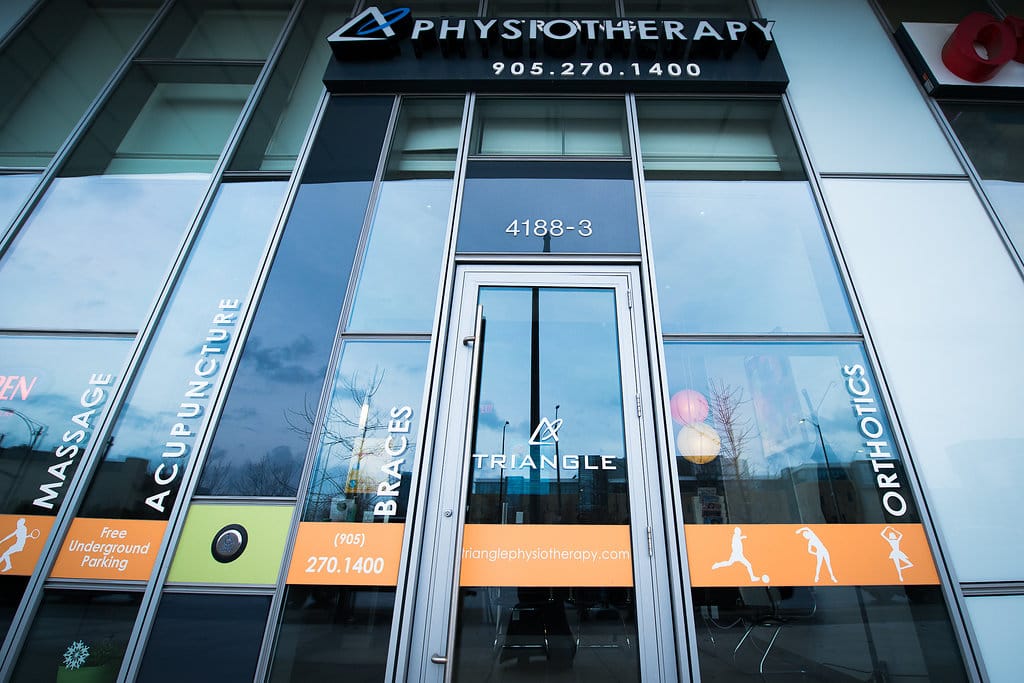
My health is very important to me so I would like to choose the best physiotherapy clinic near me. I have heard great things about you. What makes you the best physiotherapy clinic in Mississauga?
Our patients have told us many times that we offer the best physiotherapy service in Mississauga because from the second they step inside our physio clinic in Mississauga until the end of every session, our physiotherapists at our Mississauga clinic provide them with a one-on-one quality service they deserve.
I went to a physiotherapy clinic near me which I was told was the best physiotherapy clinic in Mississauga but I found out the physiotherapist who was treating me was not registered. Are all the physiotherapists at your Mississauga clinic registered?
Yes, all the physiotherapists at our Mississauga clinic are registered. We go through a rigorous vetting process for applicants when we hire our professionals, as we want to provide the best expertise and service to our patients.
I recently moved to Mississauga and am in search of a physiotherapist near me who could provide me with excellent care like my previous physiotherapist. Which physiotherapist in Mississauga would you recommend I see?
Our physiotherapists in Mississauga are all registered, highly qualified and will provide you with quality care that will exceed your expectations. We have all their profiles on our website for your review. You may also call us and we can discuss your condition further so we may recommend the physiotherapist at our physiotherapy centre in Mississauga, who we feel would best fit your condition.
What kind of services do you offer at your physio clinic in Mississauga and what makes you different from all the other clinics that offer physiotherapy services near me?
Our physiotherapy center in Mississauga offers:
- Physiotherapy,
- Pelvic Health,
- Pediatric Pelvic Health,
- Vestibular Rehab,
- Massage therapy,
- Naturopathy,
- Acupuncture, Dry Needling
- Chiropractic services.
The physio clinic near me does not provide direct billing. I would only like to go to a clinic that can do direct billing for me. Does your physiotherapy center do direct billing or do I need to pay upfront for the physiotherapy services?
Yes, our physio clinic in Mississauga offers direct billing to most insurance companies to save you time and provide you with a stress free experience.
I have vertigo and am in search of a Vestibular physiotherapist near me. Do you have a Vestibular physiotherapist in your Mississauga location?
Yes, we have a Vestibular physiotherapist at our Mississauga location. Here at the physiotherapy clinic in Mississauga, our vestibular physiotherapist will conduct a thorough assessment to establish the root of your problem and design a customised program of balance exercises to help resolve your symptoms.
If you have Vertigo (BPPV) this can be treated with a simple head maneuver called the Epley’s maneuver.
Your treatment will include exercises and education about your condition.
Who would benefit from pelvic floor physiotherapy?
Pelvic health physiotherapy is the therapeutic treatment of all disorders affecting the pelvis and pelvic floor. From incontinence to prolapse, pelvic pain, or constipation, there is growing evidence that physiotherapy can alleviate, and in many cases cure these symptoms. Pelvic physiotherapists are experienced in treating men and women.
Click HERE to book an appointment with a physiotherapist at one of our eight locations.
- Physiotherapy Etobicoke – Triangle Physiotherapy Etobicoke
- Oakville Physiotherapy Clinic – Triangle Physiotherapy Oakville
- Physiotherapy North York – Triangle Physiotherapy North York
- Mississauga Physiotherapy Clinics – Triangle Physiotherapy Mississauga
- Downtown Physiotherapy Clinics – Triangle Physiotherapy King West
- Uptown Physiotherapy Clinics – Triangle Physiotherapy Lawrence Park
- Physiotherapy Clinic Downtown Toronto – Triangle Physiotherapy Queens Quay
- Physiotherapy Clinics Mississauga – Triangle Physiotherapy Erin Mills
“Finding the closest physiotherapy clinic in Mississauga is essential for convenient access to care. Triangle Physiotherapy offers expert services across the GTA, including Physiotherapy Etobicoke, Physiotherapy Oakville, Physiotherapy North York, Physiotherapy Toronto, Physiotherapy Lawrence Park, Physiotherapy Queens Quay, Physiotherapy Erin Mills, Physiotherapy Mississauga, and Liberty Village. Our clinics are strategically located to provide you with the highest quality physiotherapy services close to home.”
At Triangle Physiotherapy, we are committed to creating an inclusive and equitable environment for our employees, clients, and the communities we serve. We believe in upholding and promoting principles of Equality, Diversity, and Inclusion (EDI) as well as safeguarding human rights. This policy outlines our commitment to these values and serves as a guide for all stakeholders associated with our clinic.
1. Equality, Diversity, and Inclusion (EDI)
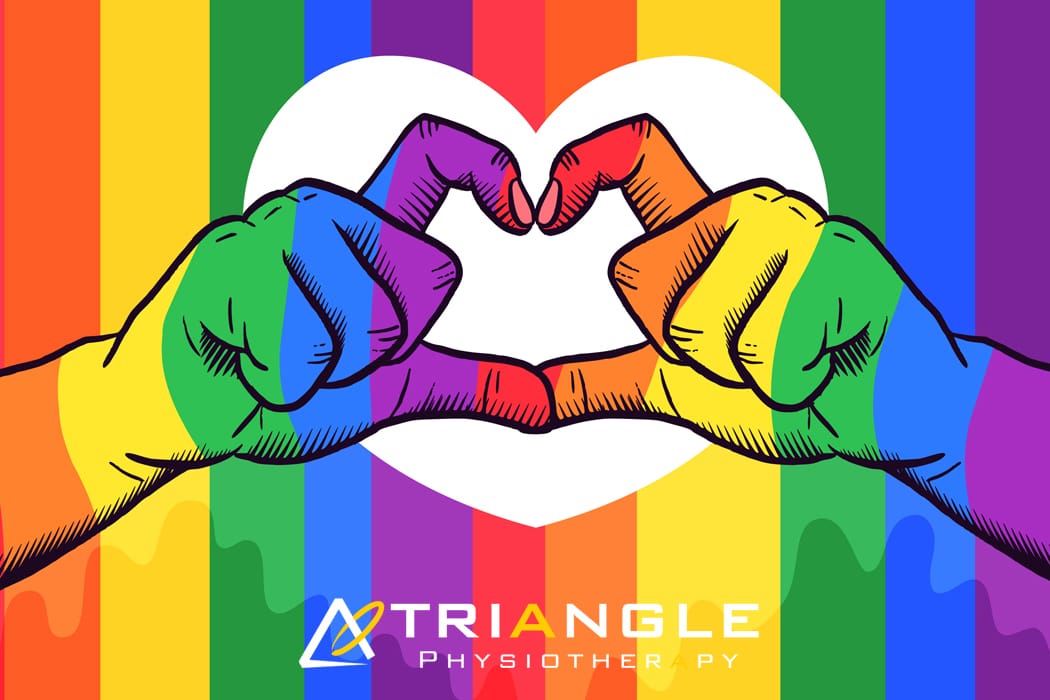
1.1. Equal Opportunities: We are committed to providing equal opportunities to all employees and clients, irrespective of their race, color, ethnicity, nationality, religion, gender, sexual orientation, age, disability, marital status, or any other protected characteristic.
1.2. Anti-Discrimination: Discrimination, harassment, or victimization of any kind will not be tolerated within our clinic. We actively promote a working environment that is free from any form of discrimination.
1.3. Accessibility: We strive to ensure that our clinic facilities, services, and information are accessible to all individuals, including those with disabilities. Reasonable accommodations will be provided to enable individuals to participate fully and equally in our programs and services.
1.4. Inclusive Culture: We foster an inclusive culture that values and respects individual differences. We encourage open dialogue, collaboration, and mutual respect among our employees, clients, and partners.
1.5. Training and Education: We will provide regular training and educational opportunities to our employees to enhance their understanding of diversity, inclusion, and unconscious bias. This will enable them to create an inclusive environment and deliver culturally competent care to our diverse client base.
2. Human Rights
2.1. Human Rights Compliance: We are committed to upholding and promoting human rights as defined by international conventions and local laws. We will not engage in any activities that violate human rights or support organizations or entities that do not align with our human rights principles.
2.2. Privacy and Confidentiality: We respect and protect the privacy and confidentiality of our clients’ personal information in accordance with applicable privacy laws and regulations.
2.3. Ethical Practices: We adhere to ethical business practices and will not engage in any form of exploitation, forced labor, child labor, or any activity that violates basic human rights.
2.4. Reporting Mechanisms: We encourage employees, clients, and other stakeholders to report any concerns related to equality, diversity, inclusion, or human rights violations. We will establish confidential reporting mechanisms and ensure that appropriate actions are taken to address reported issues.
2.5. Continuous Improvement: We are committed to continuously improving our policies, practices, and procedures to ensure that we remain aligned with evolving societal norms, best practices, and legal requirements related to EDI and human rights.
This policy applies to all employees, contractors, clients, visitors, and anyone associated with Triangle Physiotherapy. Violation of this policy may result in appropriate disciplinary action, up to and including termination of employment or termination of client relationship.
We believe that by actively promoting equality, diversity, inclusion, and human rights, we can create a positive and supportive environment that benefits everyone involved with our clinic.
Triangle Physiotherapy remains committed to reviewing and updating this policy periodically to ensure its relevance and effectiveness.
“At Triangle Physiotherapy, we are committed to Equity, Diversity, and Inclusion (EDI) and uphold human rights in all aspects of our services. We provide expert physiotherapy care across the GTA, including Physiotherapy in Etobicoke, Oakville, North York, Toronto, Lawrence Park, Queens Quay, Erin Mills, Mississauga, and Liberty Village. Our clinics are dedicated to creating an inclusive environment where everyone is treated with respect and dignity.”




